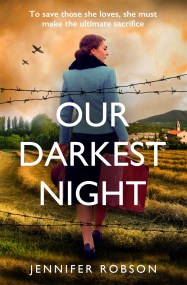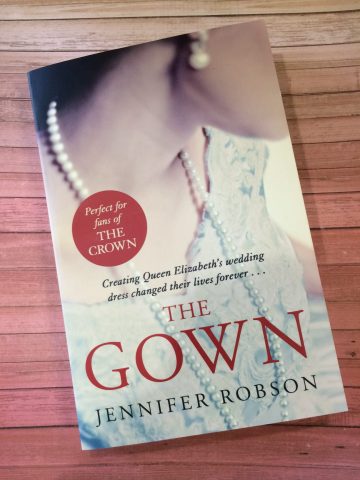Defeating the Silence by Jennifer Robson

In late 2018, shortly before the publication of The Gown, my son came to me with a question. He’d been studying the Second World War, and with it the Holocaust, in history class at school. As school-related questions go, it was a big one: “Is it true that Daddy’s grandparents hid Jewish families during the war?” he asked.
I had to tell him that I wasn’t sure. I wanted it to be true, but I couldn’t be certain.
My husband Claudio and I first heard the stories about his grandparents on a visit to Italy in May 2016. We were staying in his parents’ home town of San Zenone degli Ezzelini, about forty-five minutes to the north-west of Venice, and a few days after our arrival we went to visit one of his aunts. Claudio and Zia Maria were chatting in their local dialect when, in response to his questions, she began to talk about the war. I still remember the moment when I managed to untangle a few words from their conversation. “Hebrei,” his aunt said. “To nonno i ga scónti,” she added. Jews. Your grandfather hid them.
We peppered Zia Maria and our other relatives in San Zenone with more questions, and were astonished by their revelations. They told us that Claudio’s grandparents, Giovanni and Emma Guarda, had been asked by their parish priest to offer shelter to Jewish families in danger of arrest and deportation. Although Giovanni and Emma were poor—they shared a small farmhouse in San Zenone with their four children and his elderly mother, as well as his brother, sister-in-law, and their two children—they said yes. Between 1943 and 1945 they sheltered at least three different families, though there may have been more; their surviving children’s memories are unclear on this point.
My husband’s aunts do recall a number of telling details. The roof of the adjoining stable was the place where their guests hid when strangers came to the door; to further conceal them, a large wardrobe was pushed in front of the window that led to the stable roof. His aunts also told us how, at the very end of the war, their father gave away precious food and blankets to retreating German soldiers because he was fearful they would come into the house, take what they needed, and discover the people he was still faithfully hiding. Unfortunately, although they remember many details of the people themselves, his aunts can no longer recall their names. Giovanni died in 1991, and Emma before him in 1978; my husband never had the chance to speak to them about their lives during the war.
That is where our research would have ended if not for my son’s timely question. Could the stories be true? I decided to try to unearth some answers.
I began by consulting the online databases maintained by Yad Vashem to see if there was any quantifiable evidence of Jewish families being sheltered in San Zenone. To my surprise and relief, there was. Father Oddo Stocco, who served as the town’s parish priest from 1931 to 1948, was named Righteous Among the Nations in 2010 for his heroism in saving more than fifty Jews by securing hiding places for them among his parishioners.
Some of those parishioners were also accorded the honor of Righteous Among the Nations, though not my husband’s grandparents. But did this mean they hadn’t been involved in Father Stocco’s efforts? Or only that the accounting of those who were involved was incomplete? One sentence in the citation from Yad Vashem gave me hope, for it confirmed what I already suspected: “The entire village helped [Father] Stocco feed the dozens of Jews and many other refugees and political fugitives, despite the heavy burden this entailed, because they respected his leadership and good deeds.”
As I write this essay, in the early summer of 2020, I have yet to uncover documentary proof of my husband’s grandparents’ involvement; it may no longer be possible after such a span of time. The historian in me hesitates, ever cautious, wanting more proof, yet I cannot say that such evidence is truly necessary. And that’s because the story of Giovanni and Emma Guarda’s humble courage, the story that led me to Our Darkest Night, is not the reason I wrote this novel. I wrote it because my son’s question made me wonder about the people who were forced into hiding. What were their stories? How did they survive? And might it be possible for me, a Gentile, to write a story from their point of view?
Nina is at the center of this novel because it was her perspective, from the beginning, that resonated most profoundly for me. Every time I sat down to write, it was her eyes that allowed me to see. No other point of view seemed possible, let alone desirable. The actions of many of the Gentiles in Our Darkest Night, among them Nico, Father Bernardi, and Rosa, are selfless and heroic, as indeed were those of Father Stocco and the parishioners of San Zenone. They were heroes, to be sure; but the heart and soul of this novel belongs to Nina, and with her the thousands of Italian Jews who were persecuted, terrorized, murdered, and silenced.
In the creation of Our Darkest Night, I studiously avoided any alterations to the historical record. I also decided against featuring any known historical figures among my central characters. To fictionalize the story of Piera Sonnino, for instance, whose memoir This Has Happened was so central to my understanding of the Shoah in Italy, was unthinkable. In so doing I would be subduing her truth into my fiction. I would be silencing her voice.
Instead I searched for spaces within the historical record where my characters might plausibly reside. To employ but one example: there really was a deportation train that left the detention camp in Bolzano, Italy on October 24, 1944, and arrived at Birkenau after an indescribably harrowing four-day journey. Rather than remove any single voice from the historical record, and subsume that person’s truth into my story, I decided to add Nina’s voice to the chorus of women on the train. In so doing, I sincerely hope that I have helped to amplify the voices of those who were forced to undergo that journey, as well as the millions more whose lives were cut short by the horrors of the Holocaust.
I was inspired to adopt this approach by Susanne C. Knittel’s The Historical Uncanny: Disability, Ethnicity, and the Politics of Holocaust Memory, in which she describes the act of “vicarious witnessing.” Such an approach, she explains, “does not entail an act of speaking for and thus appropriating the memory and story of someone else but rather an attempt to bridge the silence through narrative means.”
Millions were silenced by the Holocaust. More than seventy-five years on, the inexorable passage of time is silencing the last of its survivors and its witnesses. Each year there are fewer among us who can bear direct witness to the horrors they endured; soon they will all be gone. And that is where vicarious witnesses, among them writers and historians like me, can attempt to defeat the silence. With my creation of Nina, her family, her struggles, and her triumphs, I am trying to make a difference. I am trying to act as a vicarious witness so these stories are not lost.
Antonina Mazin is a construct of my imagination, but her story was inspired by those of real people who lived, suffered, and died; people who loved and were loved; people whose lives have ended, but whose existence mattered. Their sacred memory must not be allowed to fade.







